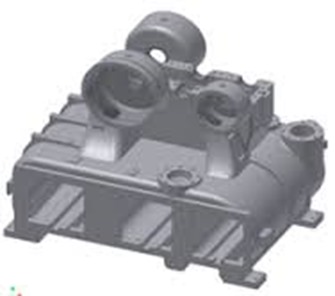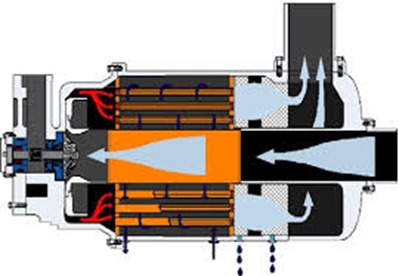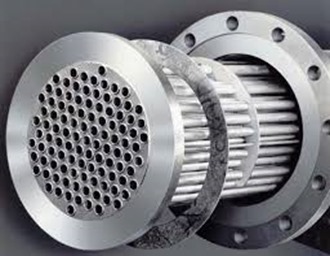We’ve discussed how the air is compressed through each component in a centrifugal compressor. Now that the air/gas has been compressed in the 1st stage, it has an elevated temperature. An example on a 400 HP machine with the air inlet temperature at 75 degrees F. the air temperature as it exits the 1st stage is approximately 242 degrees F.
As previously discussed, the ability of the compressor to meet the required performance is based on inlet pressure, inlet temperature and humidity levels. With cooler air being more dense it is also more easily compressed. Since the air leaving our 1st stage is at 242 degrees, we need to cool the air down before we move it to the 2nd stage of compression.
Enter the cooler, the next component of discussion in our centrifugal compressor. Unless, there is a very specialized application the manufacturer will supply a cooler between each stage of compression and a final cooler (after-cooler) after the final stage of compression to cool the air prior to the next stage of compression or enter the plant distribution system.
Normally on compressors as large as centrifugals the cooling medium will be water although some manufacturers do provide air to air coolers up to certain horsepower machines.
The photo above is a fairly normal centrifugal compressor gearbox and cooler casting. This is the base building block of the compressor. The 3 square holes near the bottom of the casting is where the 2 intercoolers and single aftercooler will be located. the circular holes toward the top are where the impellers and diffusers will reside and the scroll will be mounted to the outside of the circular holes once the impeller and diffuser are mounted.
Remember I stated this is a fairly typical gearbox/cooler casting. Manufacturers will incorporate a single casting design which can be utilized for several HP sizes. This saves the manufacturer money rather then a casting design for each single HP compressors.
Other designs can be found as well. One design is shown below where the cooler or cooling tubes surround the inlet air path. As you can see the air is being drawn down the center toward the impeller. The air exits the impeller/diffuser to each side where it then channels back through the cooler. The main issue with this design is the difficulty in disassembly to make any repairs unlike the casting design shown above where the coolers can be independently & easily removed.
Best in class design can accomplish even more. You can see in the photos below that certain manufacturers create separate gearbox and cooler housing castings. The thought process here is that the gearbox can still be usable for a range of HP sizes but the cooler sizing type can also be customized. By bolting the gearbox casting to the cooler casting you complete the casting assembly. In the event a client needs special large or smaller coolers or perhaps the client needs an API compressor then the gearbox casting and cooler requirements can be totally customized.
Moving on to the actual working of the cooler. The cooler itself contains a series of tubes, the inner portion of the photo below. Best design has the water flowing through the tubes although certain manufacturers reverse this and have air flowing through the tubes. The air enters the shell of the cooler and flows by the tubes containing the water. The air transfers the heat to the cooling water flowing through the tubes and the water then exits the cooler flowing back to a cooling tower, chiller or in rare cases a drain if the plant is using city water with a once through design. (A very expensive alternate) Most often the tubes are also surrounded by fins which aides in the heat transfer process.
A few other items that are important to note:
The tubes in the cooler can be either straight or U-Tubes. A straight tube design has the water entering one end of the tube, flow straight through to the other end where it exits the cooler assembly. A U-tube design (cheaper) has the water enter one end of the tube, flows to the opposite end of the cooler where the tubes bends 90 degrees and flows the water back to the originating end of the cooler where it exits. A U-tube cooler can only be chemically cleaned! A straight tube design offers the ability to remove both end caps and be mechanically rodded for cleaning. Please allocate the extra money (if required) and specify straight tube coolers!
The tubes and fins can be made of special materials depending on the service of the machine. Normal material of construction is copper tubes and aluminum fins.
You will normally hear of coolers being rated in approach temperature such as a 10 degree approach or a 15 degree approach. This simply means that the air leaving the cooler will be X degrees higher than the cooling medium – in our case normally water. Where X is the approach rating. So if a cooler is rated at a 10 degree approach and we have 80 degree water, the air leaving the cooler will be 90 degrees.
So now we’ve cooled the air down to an acceptable temperature for use in the next phase – either the next stage of compression or plant use.
If you read my dryer series you might remember when you have hot air and then cool it down you also condense water. The same thing just happened in the inter or after cooler. We had hot air (which is capable of holding large amounts of water vapor) and cooled it down so the water vapor condenses changing it to a liquid state. Now we certainly do not want liquid water going downstream to our plant and we REALLY do not want liquid water going into our next impeller! Therefore the design of the cooler casting must be such that the liquid water drops out of the air stream to a low collection point where an automatic drain valve will disperse the water to a drain outside the cooler casting.
A final note on condensate. We’re discussing water & metals which equals corrosion over a period of time. Air passages can be sprayed with an anti-corrosion coating for additional protection. Some manufacturers charge extra for this item and some provide it as standard. Yes, coating also wear away but any additional protection from corrosion is a good thing! Remember, your impellers are spinning at high speeds (up to 100, 000 RPM) with very close tolerances. A piece of rust slag hitting an impeller is not a good idea!






